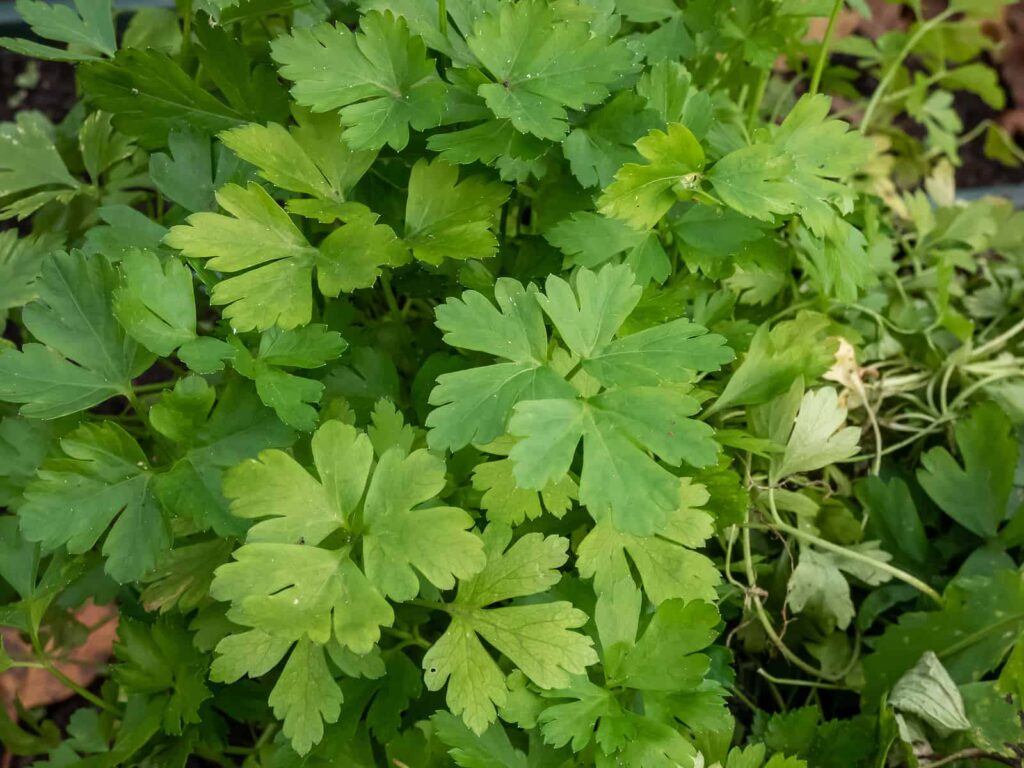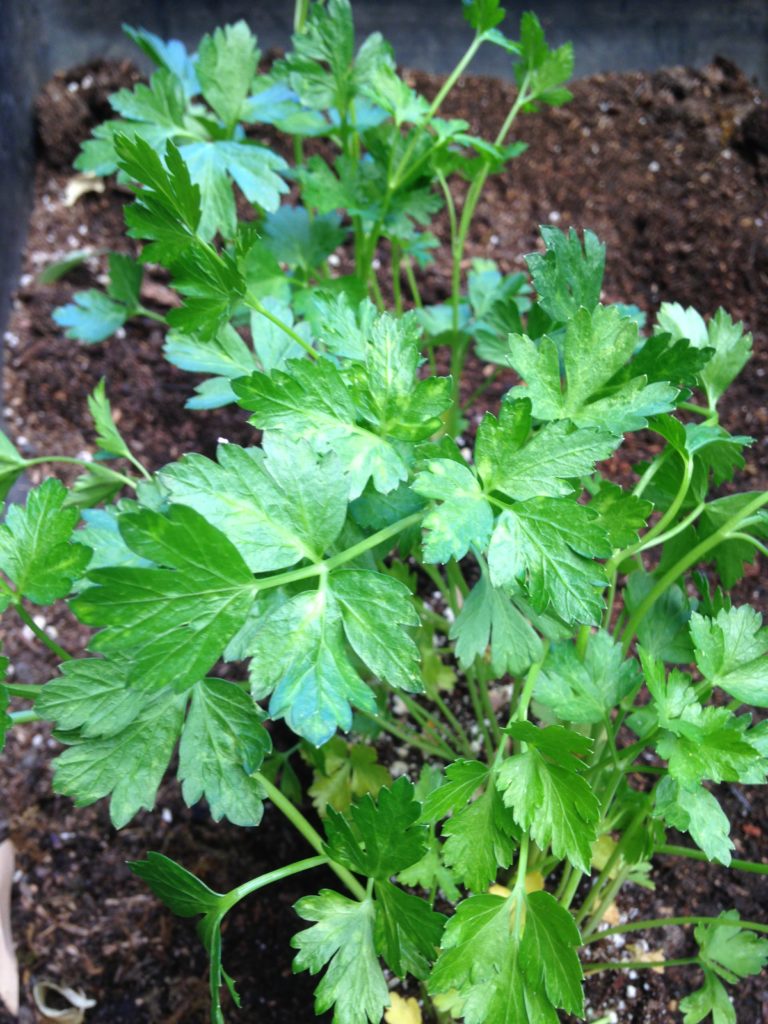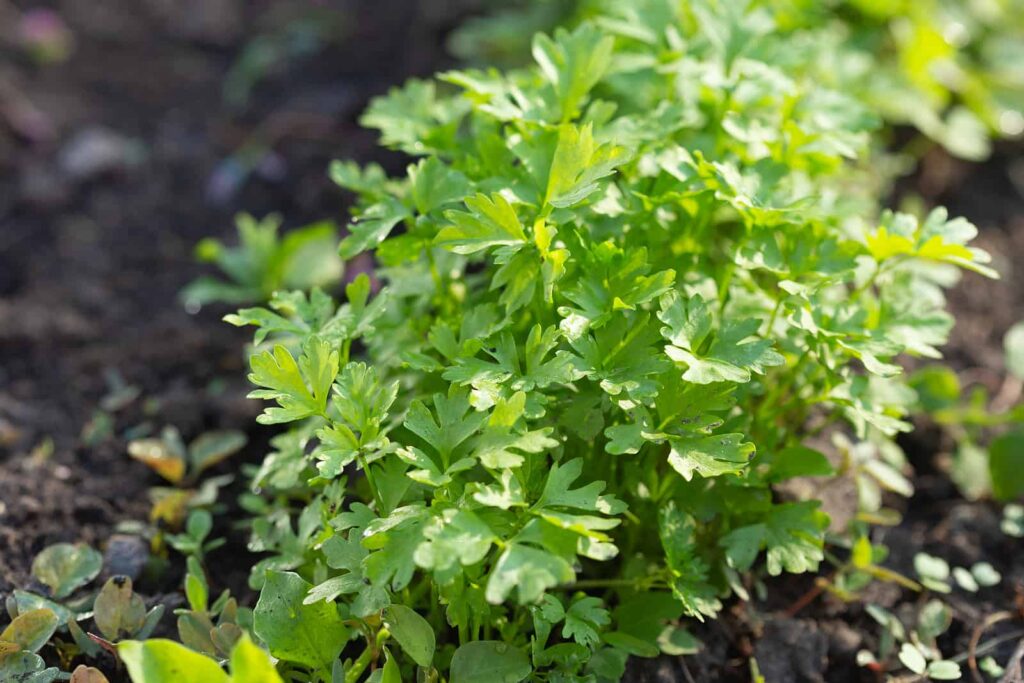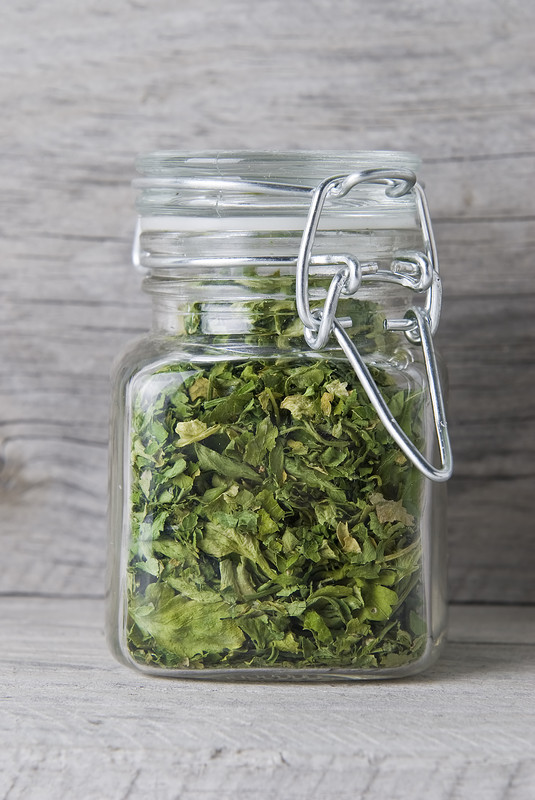Parsley is a biennial herb usually grown as an annual. There are two types of parsley: curly-leaf parsley has finely divided, ruffled leaves and grows from 8 to 12 inches tall; flat-leaf parsley has flat, bright, green leaves that resemble a celery stalk and grows 18 to 24 inches tall. Flat-leaf parsley is also called French or Italian parsley.
Sow parsley seeds directly in the garden 2 to 4 weeks before the average last frost date in spring. For transplants, start seeds indoors 4 to 6 weeks before setting transplants in the garden; transplants can be set in the garden 4 to 6 weeks before to 4 to 6 weeks after the last frost.
Good Products for Raised Bed Growing at Amazon:
- Galvanized Raised Bed 8×3
- Cedar Raised Bed 4×8
- Elevated Cedar Planter 4×2
- Walk-In Greenhouse Tunnel 15x7x7
- Row Cover for Freeze Protection 10×30
Parsley is a favorite of most Western cooks—used for its clean, fresh taste in sauces, salads, stuffings, and omelets. It’s commonly added at the end of cooking for its fresh peppery and tangy flavor. It has a light spicy aroma with hints of anise and lemon.
Parsley grows to its full size in the first season and after winter’s cold temperatures, it blooms, sets seeds, and dies in its second season. If you are growing parsley for kitchen use and not seed, you may want to simply treat the plant as an annual and plant it anew each spring.
Parsley planting details
- Sowing depth: 1/2 inch (1.2cm)
- Space between plants after thinning: 4-6 inches (10-15cm)
- Days to sprout: 11-28; soak seeds overnight then freeze for a week before sowing.
- Days to harvest: 70-90 days to reach harvest; you can begin picking leaves as you need them sooner.
- Storage period: 1-2 weeks
- Seeds per 100-row feet: 1/2 ounce (14 grams)
- Yield per 100-row feet: 50 pounds
- Suggested varieties: Afro, Flat Leaf, Triple Curled
Related articles:
Where to plant parsley
- Best location: Grow parsley in the morning sun or partial shade in the afternoon. Parsley grows best when the air temperature is about 60° to 65°F. In hot summer regions, start parsley outdoors in the fall and let it grow on through the winter.
- Soil preparation: Parsley grows best in compost-rich, moist soil with a pH between 5.5 and 6.7. Add a slow-release fertilizer to the soil before or at planting time.

When to plant parsley
- Seed starting indoors: Sow parsley indoors in late winter or early spring 4 to 6 weeks before transplanting to the garden. Soak seeds in warm water for 24 hours before planting. Seeds germinate in 5 to 6 weeks and plants mature in 70 to 90 days.
- Transplanting to the garden: Transplant parsley outdoors in mid to late spring after the soil has warmed to 50°F.
- Outdoor planting time: Sow parsley seed outdoors in spring after all danger of frost has passed and the soil is at least 50° Parsley is slow to germinate and emerge from the soil—usually 5 to 6 weeks after sowing. For best germination soak the seed overnight in warm water before sowing or pour boiling water in the planting hole before sowing the seed. In mild winter regions and hot summer regions, sow seeds outdoors from early winter to late spring.
Parsley seed sowing dates
(These dates are for the Northern Hemisphere)
| Average date of the last frost | Planting dates |
| Jan. 30 | Jan. 1-30 |
| Feb. 8 | Jan. 1-30 |
| Feb. 18 | Jan. 1-30 |
| Feb. 28 | Jan. 15-Mar. 1 |
| Mar. 10 | Feb. 1-Mar. 10 |
| Mar. 20 | Feb. 15-Mar. 15 |
| Mar. 30 | Mar. 1-Apr. 1 |
| Apr. 10 | Mar. 10-Apr. 10 |
| Apr. 20 | Mar. 20-Apr. 20 |
| Apr. 30 | Apr. 1-May 1 |
| May 10 | Apr. 15-May 15 |
| May 20 | May 1-20 |
| May 30 | May 10-June 1 |
| June 10 | May 20-June 10 |

How to speed parsley germination
Parsley seeds can be slow to germinate. To speed germination, soak seeds in water for 48 hours, changing the water twice, before planting them. Be sure to discard the water because the seeds contain compounds called furanocoumarins which block germination. After soaking the seeds, freeze them for a week before planting. An alternative is to rub the seeds between two sheets of sandpaper before sowing.
Sow seeds ½ inch deep being sure to cover the seeds because they germinate best in the absence of light. Parsley grows best sandy loam with good drainage. Parsley should be planted in full sun but will tolerate partial shade.
Harvest of a few sprigs at a time can begin once the plant is established. Potted parsley can be moved indoors in winter to continue the harvest.
- Planting depth: Sow parsley seed ¼ inch deep.
- Planting and spacing. Space parsley 6 to 8 inches apart in all directions.
- Parsley yield: Grow 6 plants for cooking; grow 10 to 20 plants for preserving.
Parsley companion plants
Grow parsley with asparagus, sweet corn, peppers, and tomatoes. Parsley is said to repel asparagus beetles and reduces the number of carrot rust flies. It’s best to grow parsley apart from like family plants including carrots, celery, and parsnips to avoid cross-pollination.
Watering and feeding parsley
- Watering: Keep the soil evenly moist; do not overwater parsley.
- Feeding: Parsley is a heavy feeder. Feed parsley with liquid seaweed extracts two to three times during the growing season. Side-dress parsley with aged compost in midseason.
Parsley care and maintenance
- Care: To keep parsley productive, cut back the full length of outside stems (cut at the base). Remove flower stalks that form. (When flowers are allowed to remain, the leaves will become bitter.) Prune away dead leaves as needed to keep the plant tidy. Towards the end of the growing season, cut back plants to promote new growth.
- Mulching: Where the weather gets hot, mulch around plants to keep the roots cool; be sure not to cover the crown which can cause rot.

Container growing parsley
- Container growing: Parsley grows and yields well in a container. Choose a container at least 6 inches wide and deep. Grow parsley indoors in summer or winter in 6-inch pots.
- Winter growing: Bring parsley indoors for winter harvest to avoid freezing damage and continue cut-and-come-again harvest. Parsley leaves grown in the house will be tougher than those grown outdoors.
Parsley pests and diseases
- Pests: Cabbage loopers, carrot rust flies, carrot weevils, whitefly, nematodes, parsley worms, and spider mites can attack parsley. The brightly striped parsley worm caterpillar which becomes the swallowtail butterfly will feed on parsley. You may want to plant enough parsley to feed the parsley worm caterpillar to support a butterfly colony. Whiteflies can attack parsley in large numbers. Spray the undersides of the leaves thoroughly with insecticidal soap to control whiteflies. Give leaves an occasional rinse to keep spider mites from infecting plants.
- Parsley usually is not attacked by disease if planted in well-drained soil. Crown rot can occur if the soil is too wet and not well-drained. Leaf spot can occur if watering is sparse or the weather is hot.

How to harvest parsley
- When to harvest: Gather parsley stems and leaves as you need them. Parsley will mature 70 to 90 days after sowing. Harvest leaves before plants flower; once flowering spikes form, the leaves will be bitter tasting. At the end of the season, let parsley flower, and collect the seeds to replant next year.
- How to harvest: Cut outer leaf stalks at the base for fresh foliage (let inner leaves continue to grow). Cut the whole plant at once and it will re-grow. Harvest parsley by cutting the leafy stems from the base of the plant—this will also serve to make the plant grow back bushier. Harvest the larger, outer leaves first. Dig roots in the fall of the first year or spring of the second year using a garden fork.
Parsley in the kitchen
- Flavor and aroma: Flat parsley has a stronger more pungent taste than curly parsley; use it sparingly so that it does not overpower other flavors. Parsley will tone down strong flavors such as garlic. Parsley is a chief ingredient in bouquet garni.
- Leaves: Use first-year leaves with salads, sandwiches, eggs, vegetables, meats, soups, stews, roasts, sauces, and vinegar. Strip leaves from coarse stems before chopping. Add leaves to green salads, potato salad, cold pasta dishes, or mince over deviled eggs. Add parsley to any savory dish, fish, and poultry. Add parsley to cottage cheese, soft cheese such as ricotta, and herb butter. Second-year leaves are unpalatable.
- Cooking: Parsley added at the last minute to cooked foods will be crisper, tastier, and greener. Flat-leaf parsley is the best flavor choice for cooking. Parsley tastes good with omelets, stews, vegetables, soups, eggs, sauces, rice, and pasta, also with fish, shellfish, meat, and poultry.

Preserving and storing parsley
- Refrigeration: Store fresh parsley in a plastic bag in the refrigerator or sprinkle with water and wrap in a paper towel, or cut the ends and place stems upright in cold water.
- Drying: Dry leaves in the refrigerator; wash them first then let them air dry spread on a baking sheet covered with paper towels. Leaves will take 2 to 7 days to dry in the fridge. Hang dry parsley in bunches or in a mesh bag to hang dry; hang dry parsley in the shade. Dried parsley quickly loses flavor; freezing leaves may be a better alternative.
- Freezing: Chop and freeze leaves in a zippered plastic freezer bag. Freezing will retain the flavor.
- Storing: Dried parsley leaves should be kept in an airtight container away from light and moisture.
Parsley propagation
- Seed: Pour boiling water over the seed before sowing or soak the seed in warm water for 24 hours or refrigerate or freeze the seed before sowing. Let a few plants go to seed at the end of the season; they will reseed for next year.
Parsley varieties to grow
- Choose from these parsley varieties: ‘Giant Italian’ and ‘Giant of Naples’ are flat-leaf Italian parsley for cooking; ‘Moss Curled’ and ‘Extra Curled’ are curly-leaf parsley.
Get to know parsley
- Botanical name: Petroselinum crispumneapolitanum (flat or plain-leafed parsley, also called Italian parsley); Peroselinum crispum (curly leafed parsley. Parsley is a member of the Apiaceae – carrot and parsley family.
- Origin: Eastern Mediterranean
- Type of plant: Biennial plant is usually grown as an annual.
- Growing season: Spring through fall
- Growing zones: Zones 5 to 9
- Hardiness: Parsley can withstand frost but does not tolerate very hot weather; plants thrive in soil between 60°F and 65°
- Plant form and size: Grows 12 to 20 inches tall in clumps of deep green foliage.
- Flowers: White to yellowish-green flowers grow on flat clusters called umbels; flower stalks form in the second year growing to 24 inches high
- Bloom time: Blooms early to midsummer in the second year.
- Leaves: Rosette of dissected leaves that resemble carrot leaves. Curly parsley leaves are tufted and finely cut with serrated or toothed edges and wrinkled surfaces. Plain-leaf or Italian is similar but has a flat surface. Individual leaves consist of a leafstalk, side branches, and several separate leaflets.
Also of interest:
- Anise
- Anise Hyssop
- Arugula
- Basil
- Bay
- Bee Balm
- Borage
- Calendula
- Caraway
- Catnip
- Chamomile
- Chervil
- Chives
- Cilantro-Coriander
- Clary
- Costmary
- Cress
- Dill
- Fennel, Sweet
- Horseradish
- Hyssop
- Lavender
- Lemon Balm
- Lemongrass
- Lemon Verbena
- Lovage
- Marjoram
- Mint
- Nasturtium
- Oregano
- Parsley
- Perilla
- Rosemary
- Sage
- Salad Burnet
- Savory
- Scented Geranium
- Shiso
- Sorrel
- Stevia
- Sweet Cicely
- Tarragon
- Thyme
Garden Planning Books at Amazon:
- Vegetable Garden Almanac & Planner
- Kitchen Garden Grower’s Guide Vegetable Encyclopedia
- Vegetable Garden Grower’s Guide
- Tomato Grower’s Answer Book















